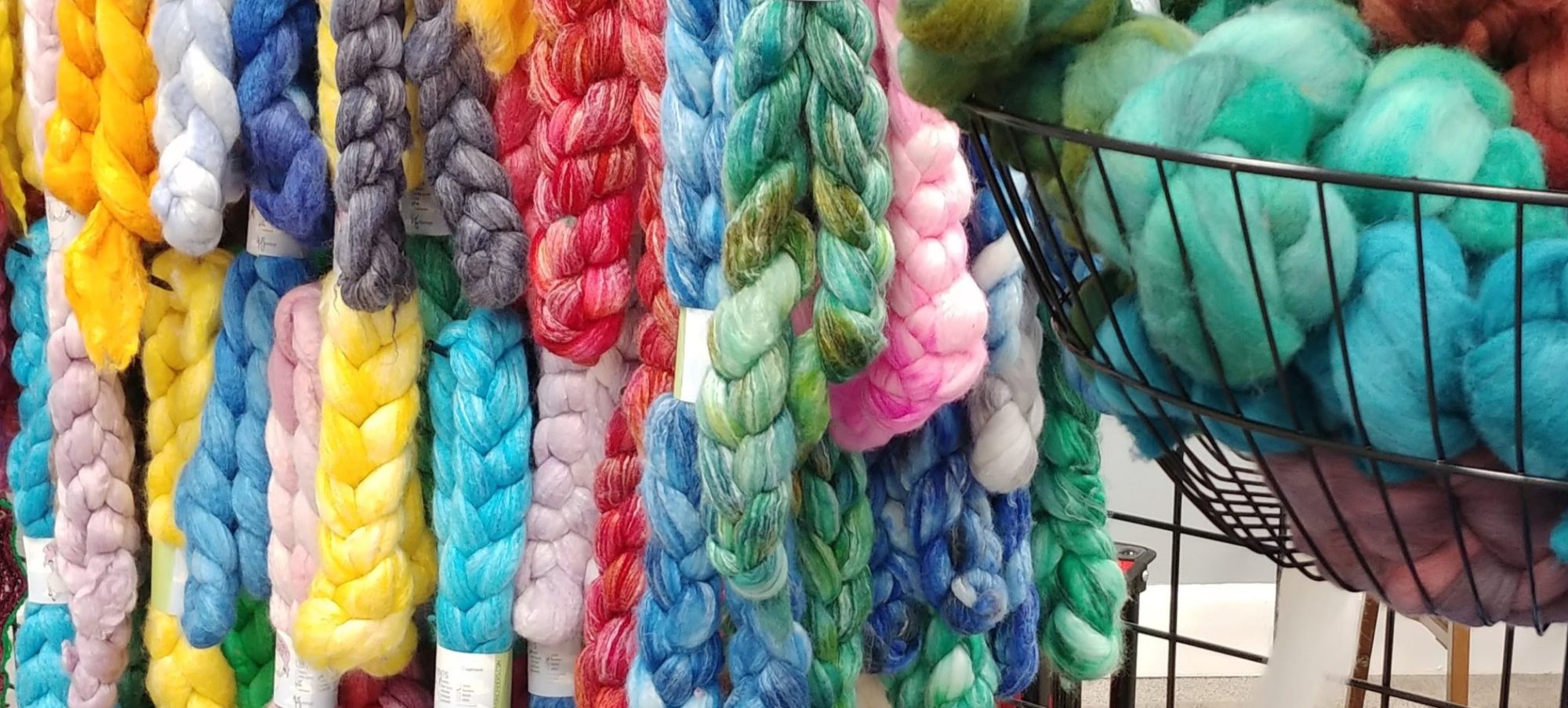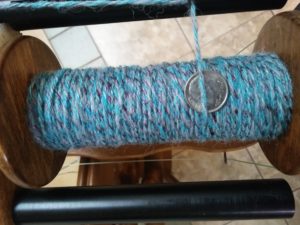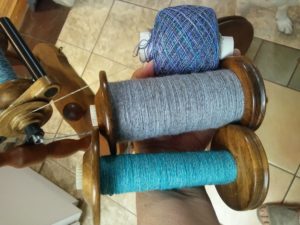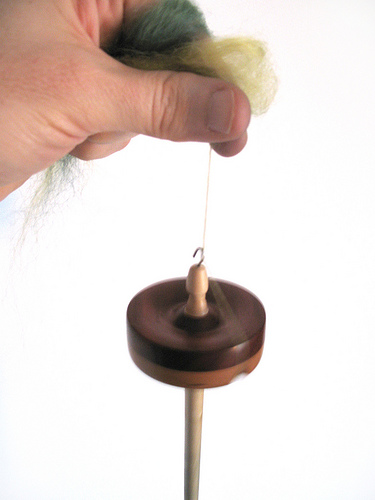Argentina is lovely in the fall! The days were unseasonably warm at the beginning of the trip, but the nights were cool and comfortable for sleeping. Here in Florida we are in late spring but below the equator, April is early fall. The shepherds had already moved their herds of cashmere goats to the winter feeding grounds. The area was still green due to the warm weather, but it is still not a very productive landscape.
I was able to travel down to Patagonia on a grant from Eileen Fisher given to the Wildlife Conservation Society (WCS) to continue work with the cashmere cooperative (Grupo Cost del Rio Colorado). It has been 1.5 years since I’ve been down there. I was greeted warmly, and the shepherds were anxious to see me and show what they had done, despite some significant setbacks. When I was in Patagonia the last time, a primary topic of conversation was when to comb the goats and whether or not the areas of the goat should be separated, ie, body fiber from leg fiber. The cooperative is still figuring out where the accessible points of added value are in the process of going from fluff on the goat to a finished garment. Some questions have an obvious answer. In this country, we wash fibers before processing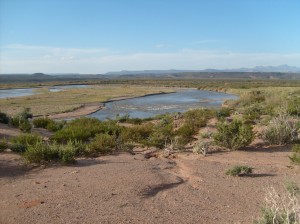 them. However, if you do not have water readily available, washing is not a viable option. Potable water is delivered by the government to many of the families that live in very remote areas. If a family is fortunate enough to have a puesto close enough to a river then the animals have readily accessible water. If not, then the family needs to share some of their water to keep animals alive.
them. However, if you do not have water readily available, washing is not a viable option. Potable water is delivered by the government to many of the families that live in very remote areas. If a family is fortunate enough to have a puesto close enough to a river then the animals have readily accessible water. If not, then the family needs to share some of their water to keep animals alive.
So where is their value-added point? The answer is combing the fibers earlier in the season and separating the fibers based on what part of the body it came from as well as the color. This time the cooperative separated the combing times, August and September, as well as the body parts, flank (body) from legs. They did this as a result of our discussions the last time I was down and out of curiosity as to whether or not it would really make a difference. This is a significant effort on their part. Unlike our spoiled dogs and cats, these goats do not want to stand still and be groomed; they want to get out onto the pasture to eat! So a few minutes a day per animal is all the shepherds get. Eventually the animal will be fully combed out, but it is labor intensive and the shepherds are very conscious of how much time they spend combing when the animal could be out eating. Food is a very precious commodity.
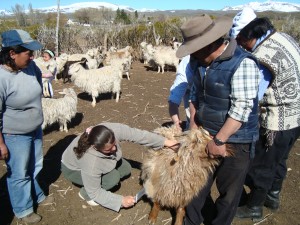 What a difference it made! Across the board, the quality of the fiber was better and there was much less guard hair which translates to a much smaller loss during dehairing for the combings done in August and from the flank. I purchased almost all they had! I also purchased some combed in September and some leg fiber from younger animals. Colors are separated into white, beige, and gray. The grays are by far much finer than the white or beige. I think that the opposite is true here and in Asia because people breed specifically for fine white, which can then be made any color, whereas on the Steppe, they simply separate the colors. Very interesting! By the way, dyeing beige and gray produces fabulous rich, complex colors that cannot be replicated with white fiber!
What a difference it made! Across the board, the quality of the fiber was better and there was much less guard hair which translates to a much smaller loss during dehairing for the combings done in August and from the flank. I purchased almost all they had! I also purchased some combed in September and some leg fiber from younger animals. Colors are separated into white, beige, and gray. The grays are by far much finer than the white or beige. I think that the opposite is true here and in Asia because people breed specifically for fine white, which can then be made any color, whereas on the Steppe, they simply separate the colors. Very interesting! By the way, dyeing beige and gray produces fabulous rich, complex colors that cannot be replicated with white fiber!

I sorted raw combed fleece and determined what I was going to buy and why. I then lined up the bags of fibers from the worst (closest) to best so they could touch and look. I answered questions about the qualities and features I was looking for and how those would impact my final product.
Then they got to see the dehaired cashmere from the last 2 years for the first time. What you see on the table is all of the dehaired fiber from the last 2 years, about 5.5 kg! A fire on the steppe eliminated much of the graze and decimated the herds. The surviving animals had to be moved much longer distances for summer grazing and there was no fiber crop that year. As the coop members were beginning to recover, one of the oil extractive companies had a major spill in the grazing area and many hundreds of goats, sheep, cattle, and horses died from poisoning by the spill. There was a very limited amount of fiber harvested this August and September. It has been a very difficult 2 years for the shepherds.

Some of the Grupo Cost del Rio Colorado cooperative members and Ginger holding dehaired cashmere. They are seeing for the first time the fruits of their labors and Ginger is very happy to purchase those fruits! As you can see this is a harsh, albeit beautiful, environment and it is amazing that the shepherds and their animals survive, even thrive, and are able to produce such a wonderful fiber!


What is life really like on the Patagonian Steppe? It is a harsh existence for the shepherds and their animals. Many of the shepherds are Mapuche Indians or descendants of the Mapuche. The families live fairly solitary lives on their puestos (ranch homes) which are often many miles apart. A family with 500 goats may need 5000 hectares (12,400 acres) to successfully graze their sheep, goats, cows, and horses. The land is very sparse and yields its resources grudgingly.
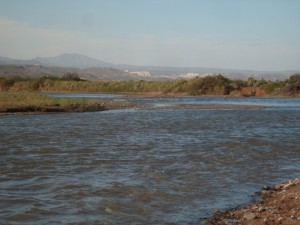 Lolo and Susanna’s winter home sits about half a mile from the Colorado River so they have water for their animals. However, they are also in danger of their home being washed away if flooding occurs. This is their ‘new’ home as the previous home several miles further along the river was washed away 10 yrs prior.
Lolo and Susanna’s winter home sits about half a mile from the Colorado River so they have water for their animals. However, they are also in danger of their home being washed away if flooding occurs. This is their ‘new’ home as the previous home several miles further along the river was washed away 10 yrs prior.

Their home is built on a concrete pad so the house has a concrete floor. Inside there are two rooms, one for cooking, eating, and living and one for sleeping. They have a gas stove with an oven in the house, which is not very common. Most have a cooking pit in a covered area near the house and an adobe oven for bread baking where they cook year round. The ‘barn’ houses the saddles for the horses and a cooking area. Their house is ‘upscale’ and has a baño behind a large bush not too far from the house. The bucket of water is for ‘flushing’ although there is no scoop other than cupped hands. Lolo and Susanna have raised seven children and now grandchildren here. Lolo jokes that he and his wife have been more productive than the goats!


On our way to visit another family, we needed to make a pit stop. The vista is never ending! We were driving through an area that had volcanic activity only a few thousand years ago. As a result there are large black rocks produced by the lava flows that make walking more difficult and the shrubs are not as high, a bit of a problem if you are hoping for a bit of privacy when relieving yourself!
This bathroom comes with a view! A large bush is behind me and this is the view in front of me. What is not apparent is that the shadow at the bottom of the picture is a drop off of several hundred feet to the bottom of the canyon floor. That is the bottom of the cut through and not a level expanse between where I’m standing and the hills opposite! The black rocks in the foreground are lava. This is an area that was created by volcanic activity.

At the next puesto we were greeted warmly, as usual. Lunch was on the spit and roasting.

They sacrificed a goat kid for us, an honor. Notice the little boy, about 5 yrs old, with his asado knife in his belt. He probably helped to slaughter and skin the goat. The young lady in the background is the thirteen-year-old daughter holding a platter receiving the chunks of goat meat. She will be finishing her middle school education this year. She and the family will then decide if she will continue with her education or if she will come back to the puesto to pitch in. Education is mandatory through middle school and then is voluntary. Children from the country are sent to the closest town where they spend the school year in a boarding school and return home for the summer when all hands are needed.
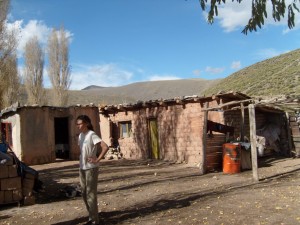

Caro, a WCS veterinarian, is standing in front of a typical house. It is built of adobe type brick from mud and straw. The floors are dirt. To the far right is the ‘kitchen,’ the fire pit where the goat was cooked. The long area of the house with the green door, the only door in the house, is the sleeping area. The whole family sleeps and generally lives in that section. On the left is the eating and cooking area. You can see the table in the doorway. There is a cloth on the table in our honor. This is where the family gathers to prepare foods for cooking, eating and to greet visitors. There is a very small gas stove in the back corner of the room that is used to cook fried bread and boil water for mate. The baño is whatever bush you are comfortable using. There is no running water, electricity, or heat. This family has lived here for many years, perhaps multiple generations. The government has recently made small solar panels available to the country people. It is sufficient to power one light for several hours at night.
It is quite arid, so the skin from the goat that was slaughtered in the morning and eaten at lunch was already mostly dry. Flies are not a problem, as things dry so quickly they don’t get much of a chance to lay eggs on fresh meat. The black circular thing is the fire pit where the goat was roasted.
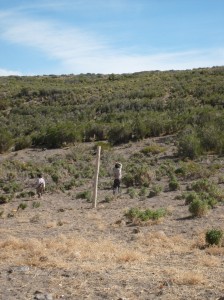 The little boys, about five and seven yrs old, entertained themselves riding their stick horses and practicing swinging and tossing their boleadoras. This will be a vital skill when they are older and riding out to wrangle cattle, sheep, and goats. In the meantime being able to take aim and ‘capture’ the post will have to do.
The little boys, about five and seven yrs old, entertained themselves riding their stick horses and practicing swinging and tossing their boleadoras. This will be a vital skill when they are older and riding out to wrangle cattle, sheep, and goats. In the meantime being able to take aim and ‘capture’ the post will have to do.
I returned with half of all the dehaired cashmere and about 3 kg of raw cashmere. I’ll combine the raw cashmere fluff from the first trip with the fluff from this trip for the dehairing process. I’ll get a much better yield than if I had processed them separately. Once back in the states, I was fortunate enough to be able to sell about half of the dehaired cashmere that I returned with before I even got home! I have made arrangements to get the rest of the dehaired fiber in September.
Ewephoric Fibers now has enough raw cashmere to be able to plan some unique blends with fine wool and silk. These will be proprietary blends that will be available only through the shop so stay tuned and be one of the first to buy some of this luxurious fiber! A portion of every sale will go into a fund that will go back to the cooperative to facilitate continued production of Patagonian cashmere.
